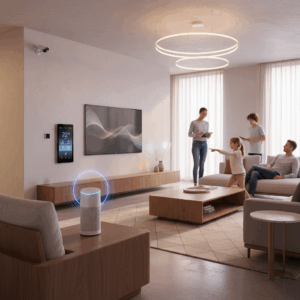History and Early Developments of Voice Assistants
The evolution of voice assistants began decades ago, with early systems focusing on basic voice recognition technology. These initial innovations laid the groundwork for modern AI-powered helpers.
Over time, improvements in technology made voice recognition more practical and accessible, transforming it from experimental to everyday use and setting the stage for digital assistants we know today.
This historical progression demonstrates how human interaction with machines shifted towards more natural, voice-based communication, enabling hands-free control and convenience.
Origins of Voice Recognition Technology
Voice recognition technology dates back to the 1960s when research aimed to interpret spoken commands using early computing systems. These pioneering efforts were limited but groundbreaking.
Initial systems struggled with accuracy and usability, but they introduced key concepts like speech pattern analysis and phoneme detection, essential for later advances.
Continued innovation throughout the decades addressed challenges such as varied accents and continuous speech, improving the reliability of voice-based interfaces.
By the early 2000s, these technologies began to support increasingly complex tasks, laying the foundation for smarter digital assistants.
Siri’s Creation and Integration into iPhone
Siri originated from Stanford Research Institute projects and launched as a standalone app in 2010, showcasing a new level of conversational AI capability for users worldwide.
Apple’s acquisition of Siri and its integration into the iPhone 4S in 2011 marked a turning point, making voice assistants widely accessible and essential for mobile device interaction.
This integration allowed users to perform tasks like messaging, setting reminders, and searching the web naturally, revolutionizing smartphone usage.
Impact of Siri’s Debut
Siri’s deployment demonstrated the practical benefits of voice assistance, inspiring competitors and igniting an era of rapid innovation in smart, speech-driven technology.
Major Players and Market Expansion
The voice assistant market expanded rapidly with key players introducing advanced, context-aware technologies. These creations transformed voice assistants into essential digital helpers.
Major companies competed to enhance natural language understanding and broaden the applications of assistants, driving adoption in mobile and home environments.
This competition fueled innovation and shaped the evolution of voice assistants from simple mobile tools to comprehensive smart home solutions.
Introduction of Google Now and Cortana
Google Now debuted in 2012, offering predictive, context-driven assistance by integrating with users’ data to provide timely information without explicit requests.
Microsoft introduced Cortana in 2014, emphasizing productivity with calendar management, reminders, and seamless Windows integration to support daily tasks.
Both assistants aimed to provide more proactive and intelligent responses, advancing the state of conversational AI beyond basic voice commands.
They expanded voice assistants’ functionality by focusing on personalized, context-aware experiences across multiple devices and platforms.
Amazon Alexa and the Smart Home Revolution
Amazon launched Alexa in 2014, revolutionizing the market by embedding voice control into the home via the Echo smart speaker, changing user interactions markedly.
Alexa enabled hands-free management of smart devices, music, and information, creating a new paradigm of ambient intelligence in daily environments.
This breakthrough positioned voice assistants as integral parts of smart homes, fostering a rapidly growing ecosystem of compatible devices and services.
Alexa’s open platform accelerated third-party skill development, enhancing its capabilities and expanding practical uses far beyond initial expectations.
Shift from Mobile to Ambient Assistants
The transition from mobile-focused assistants to ambient, always-on devices marked a significant shift in user interaction and assistant accessibility.
Voice assistants moved from reactive tools to proactive helpers, anticipating user needs in real time across diverse settings and devices.
This shift emphasized seamless integration into users’ environments, making voice control a natural part of everyday life rather than a separate task.
As assistants became embedded in homes, cars, and wearables, their role evolved towards continuous, context-driven support beyond smartphones.
Technological Advancements in AI and NLP
Recent advancements in artificial intelligence and natural language processing have significantly enhanced voice assistants’ ability to understand and interact naturally.
Machine learning models now allow assistants to interpret complex language patterns, improving accuracy and enabling context-aware conversations across diverse scenarios.
These technologies transform voice assistants from basic command engines into intelligent companions that adapt and learn with continued use.
Machine Learning and Context Awareness
Machine learning enables voice assistants to recognize patterns in speech and adapt responses based on previous interactions, making conversations more fluid and relevant.
Context awareness allows assistants to maintain information across multiple queries, understanding user intent beyond isolated commands for better service.
This ability to track context reduces the need for repetitive explanations, creating seamless and efficient user experiences in both simple and complex tasks.
As a result, assistants better handle ambiguous or incomplete inputs by referencing past interactions, which improves overall communication quality.
Personalization and Advanced Capabilities
Personalization is a key advancement, with assistants learning user preferences, routines, and speech nuances to deliver tailored responses and suggestions.
These systems can manage intricate tasks like shopping, scheduling, or controlling multiple smart devices, showcasing their expanding functionality and intelligence.
Enhanced capabilities also include integration with third-party apps and services, allowing seamless workflow automation and hands-free control over diverse domains.
Future Trends and Challenges
The future of voice assistants lies in becoming truly proactive and context-aware to better anticipate user needs. They aim to blend seamlessly into daily environments.
As these assistants evolve, they will leverage advanced AI to offer personalized and timely support, transforming user interaction from reactive commands to ongoing assistance.
This evolution presents challenges, including maintaining user privacy and securing sensitive data, which are critical to sustaining trust in voice technologies.
Proactive and Context-Aware Assistance
Future voice assistants will harness machine learning to understand context deeply, predicting user intentions before being explicitly prompted. This enhances convenience and usability.
By integrating data from multiple devices and sensors, assistants can deliver more relevant responses, adapting to changing user environments and preferences dynamically.
Such capabilities will extend beyond simple tasks, enabling assistants to coordinate complex activities like scheduling, reminders, and smart home management intelligently.
Privacy and Data Security Considerations
As voice assistants collect more personal data, protecting this information becomes paramount. Users demand transparency and control over how their data is used.
Developers must implement robust encryption and stringent data handling policies to prevent breaches and unauthorized access to sensitive voice interactions.
Balancing proactive assistance with privacy concerns will be a key focus, ensuring that enhanced functionality does not compromise user trust or security.






